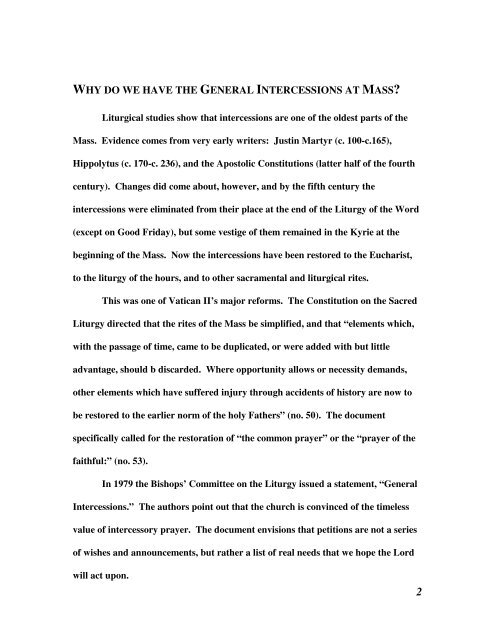Leading Children to Pray the General Intercessions - Janet ...
Leading Children to Pray the General Intercessions - Janet ...
Leading Children to Pray the General Intercessions - Janet ...
You also want an ePaper? Increase the reach of your titles
YUMPU automatically turns print PDFs into web optimized ePapers that Google loves.
WHY DO WE HAVE THE GENERAL INTERCESSIONS AT MASS?<br />
Liturgical studies show that intercessions are one of <strong>the</strong> oldest parts of <strong>the</strong><br />
Mass. Evidence comes from very early writers: Justin Martyr (c. 100-c.165),<br />
Hippolytus (c. 170-c. 236), and <strong>the</strong> Apos<strong>to</strong>lic Constitutions (latter half of <strong>the</strong> fourth<br />
century). Changes did come about, however, and by <strong>the</strong> fifth century <strong>the</strong><br />
intercessions were eliminated from <strong>the</strong>ir place at <strong>the</strong> end of <strong>the</strong> Liturgy of <strong>the</strong> Word<br />
(except on Good Friday), but some vestige of <strong>the</strong>m remained in <strong>the</strong> Kyrie at <strong>the</strong><br />
beginning of <strong>the</strong> Mass. Now <strong>the</strong> intercessions have been res<strong>to</strong>red <strong>to</strong> <strong>the</strong> Eucharist,<br />
<strong>to</strong> <strong>the</strong> liturgy of <strong>the</strong> hours, and <strong>to</strong> o<strong>the</strong>r sacramental and liturgical rites.<br />
This was one of Vatican II’s major reforms. The Constitution on <strong>the</strong> Sacred<br />
Liturgy directed that <strong>the</strong> rites of <strong>the</strong> Mass be simplified, and that “elements which,<br />
with <strong>the</strong> passage of time, came <strong>to</strong> be duplicated, or were added with but little<br />
advantage, should b discarded. Where opportunity allows or necessity demands,<br />
o<strong>the</strong>r elements which have suffered injury through accidents of his<strong>to</strong>ry are now <strong>to</strong><br />
be res<strong>to</strong>red <strong>to</strong> <strong>the</strong> earlier norm of <strong>the</strong> holy Fa<strong>the</strong>rs” (no. 50). The document<br />
specifically called for <strong>the</strong> res<strong>to</strong>ration of “<strong>the</strong> common prayer” or <strong>the</strong> “prayer of <strong>the</strong><br />
faithful:” (no. 53).<br />
In 1979 <strong>the</strong> Bishops’ Committee on <strong>the</strong> Liturgy issued a statement, “<strong>General</strong><br />
<strong>Intercessions</strong>.” The authors point out that <strong>the</strong> church is convinced of <strong>the</strong> timeless<br />
value of intercessory prayer. The document envisions that petitions are not a series<br />
of wishes and announcements, but ra<strong>the</strong>r a list of real needs that we hope <strong>the</strong> Lord<br />
will act upon.<br />
2






